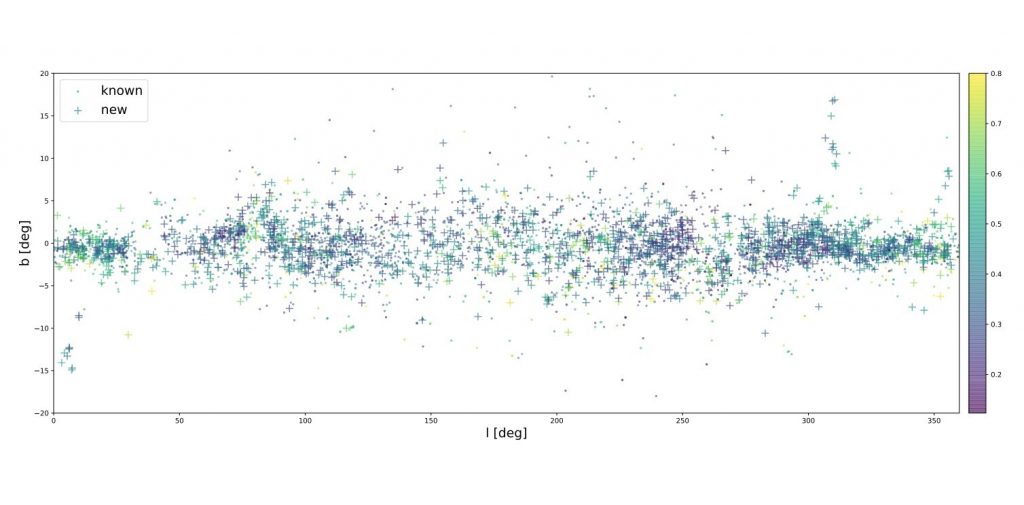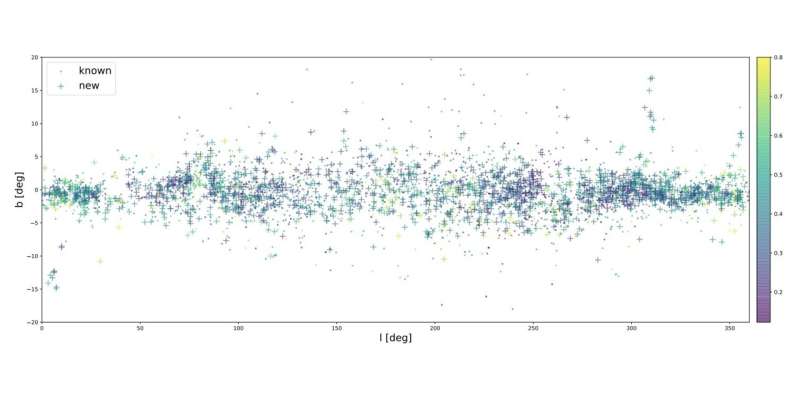
Chinese astronomers discover more than 1,600 new star clusters (Image Credit: Phys.org)

By analyzing the data from ESA’s Gaia satellite, astronomers from the China West Normal University have detected 1,656 new star clusters in our Milky Way galaxy. The discovery was presented in a research paper published September 18 on the arXiv pre-print repository.
In general, star clusters (SCs) are large gravitationally bound groups of stars. They are perceived as important laboratories for studying the evolution of stars and the clusters themselves. SCs are also good tracers for exploring the structure of the Milky Way.
It is estimated that the Milky Way may contain about 100,000 star clusters. The researchers suppose that many undiscovered clusters are still hidden in dense stellar regions.
Now, a team of astronomers led by Zhihong He reports the detection of more than 1,600 SCs in the Milky Way’s disk. The discovery is based on the early third data release (EDR3) from Gaia, improving the overall SC identified with this satellite to nearly 6,000. EDR3 provides more abundant stellar radial velocity, which offers a great opportunity to study cluster membership and kinematics.
“Our approach focused on searching for SCs that were concentrated in position and motion in the galactic disk. The subsequent analysis was then based on astrometric data from Gaia EDR3… The new findings presented in this work increased the cluster sample size by more than 30%, expanding the total number of galactic clusters to about 6,000,” the researchers explained.
The team performed a blind search of the galactic plane beyond 3,900 light years from the solar system based on the EDR3 data. They employed DBSCAN, an unsupervised machine learning algorithm widely used in cluster searches.
In result, after clustering and cross-matching with existing cluster catalogs, the astronomers found 1,656 new SCs and more than 48,000 member stars. Photometric data of this new SC sample indicate that they had the appearance of conventional cluster color-magnitude diagrams (CMDs), and their sizes and proper motion dispersions are also consistent with currently identified clusters.
It turned out that the newfound SCs are mostly located within 16,000 light years away from the Earth. They are generally older than those located at closer distances and they suffered from a significantly greater degree of extinction than nearby clusters.
“This meant that the current cluster search was still affected by extinction, and since fainter old clusters were difficult to detect, it is reasonable to believe that there are many undiscovered clusters still hidden from Gaia’s view,” the researchers concluded.
All in all, most newly discovered SCs were found to have the photometric signature of open clusters. However, the study also identified a cluster that resembles a globular cluster, which received the designation CWNU 1944. This cluster is located some 12,600 light years away and contains only evolved stars.
Zhihong He, Xiaochen Liu, Yangping Luo, Kun Wang, Qingquan Jiang, Unveiling hidden stellar aggregates in the Milky Way: 1656 new star clusters found in Gaia EDR3. arXiv:2209.08504v1 [astro-ph.GA], arxiv.org/abs/2209.08504
© 2022 Science X Network
Chinese astronomers discover more than 1,600 new star clusters (2022, September 27)
retrieved 28 September 2022
from https://phys.org/news/2022-09-chinese-astronomers-star-clusters.html
part may be reproduced without the written permission. The content is provided for information purposes only.





